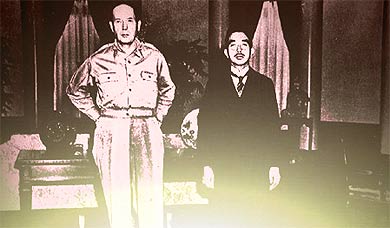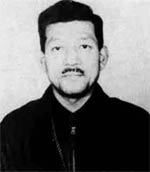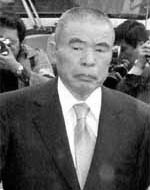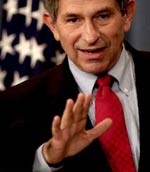After the 1930’s, while the Japanese imperial army looted Southeast Asia, Emperor Hirohito launchd “the Golden Lily Operation”, aimed at recovering and hiding his war booty. At the end of World War Two, US general McArthur’s troops took hold of the treasure and raised funds to finance the struggle against communism. “Yamashita’s Gold”, considered a simple legend for many years, allows you to understand how the Japanese Democratic Liberal Party, despite the great corruption of its elite, kept an exclusive control of the Japanese “democracy” for half a century. This is part three of a series of articles on Japanese war criminals, their links with the Mafia, their political power and the American support they received to commit their misdeeds, under the pretext of fighting against communism. The history of “democracy” advocates.

In 1895, Queen Min was burned alive by a group of murderers of the Black Ocean Society, an ultranationalist group led by legendary Mitsuru Toyama. The operation, aimed at destabilizing the Korean government, constituted one of the elements of the conquering strategy used by the Japanese secret service designed in conjunction with the yakusas of Toyama.
The assassination of the Queen gave rise to the “incident” that justified the progressive invasion against Korea. In 1905, the country became a protectorate of Japan. The ultranationalist societies began the looting operations while the underworld chiefs took on key positions. With the support of the imperial government, Ryohei Uchida, chief of the Black Dragon Society, and Toyama’s right hand, put together the militias in charge of extorting money from Korean rich families.
In 1910, Korea was fully annexed. The military chief, general Yamagata, commissioned Terauchi to undertake the secret police activities, which had initially been established by Black Dragon. The kempeitai carefully arranged the plundering of the territory, with the support of the Toyama and Uchida’s militias. Officially, Japan attempted to Project Southeast Asia from the Western settlers, by founding a “sphere of joint prosperity”.
The Japanese imperial dynasty really oversaw the ongoing plundering of the country, stealing gold and masterpieces (the valued celadon porcelain), destroying the cultural heritage (Buddhism temples) with the clear intention of doing away with the Korean identity.

A similar system was established in Manchuria, under the command of Nobusuke Kishi and the yakusa societies. The annexed territory enabled Japan to control the access by sea to the commercial ports in the North of China. The puppet government was then under the domain of the tairiki ronin -officers, chief warriors, drug traffickers... Entrepreneurial Yakusas made up true private armies to plunder territories on behalf of the Emperor, or they formed an alliance with the Chinese patrons of the Green Band to control the distribution networks of opium and its by-products.
Ryoichi Sasakawa [1] and Yoshio Kodama [2] therefore amassed great fortunes, which at the end of the war, would allow them to finance the creation of the almighty Liberal Democratic Party (LDP).
The chiefs of these groups of criminals with expeditious methods were Nobusuke Kishi and his clan, which included general Hideki Tojo (chief of the secret policy and future Prime Minister of the Government during the war years), Hoshino Naoki (chief of the opium monopoly), Matsuoka Yosuke (chairman of Mantsetsu corporation) and Aikawa Gisuke (Nissan leader). They planned the looting operations with the complicity of the Emperor.

They founded the Manchues Heavy Industry Company, an organization that coordinated the development of the industry and concentrated the booty that the army and the yakusas had looted from the local population, through the use of different methods such as demanding ransoms, extorting money, robbing banks ...
Plundering was controlled by the Japanese Empire princes: “Golden Lily Operation”
The conquering obsession upset Western leaders, who feared that Japan might interfere in their own colonies and concessions. In 1936, in the midst of the full plundering of Korea, the Japanese strategists hesitated between two choices. One of the tactics was to take control of Siberia, a territory with abundant natural resources, to set up a security area in front of the Soviet Union, main rival in the region.
This “anticommunist” strategy had the merit of pleasing one part of the West elite. For this purpose, the Ambassador to London, Yoshida, attempted to set up an alliance with the British, resorting to the support of the Cliveden group. Several ultraconservatives in the United States, like former President, Herbert Hoover, or the Nazi pilot, Charles Lindberg, and officers close to general MacArthur, favored an understanding with the imperial dynasty.
Prince Chichibu, Hirohito’s brother, traveled to London in 1936 to arrange a potential Anglo-Japanese alliance. It wa likely that the possibility to create an anticommunist front seduced the British diplomats; however the advance of the Japanese troops in Asia threatened the European powers’ colonies. Very soon, Chichibu was deprived of every means of negotiation.
The army was totally out of control in China. In 1937, several officers were plotting the Marco Polo incident in China, which resulted in the invasion of the country by the Japanese troops with the unofficial support of the Emperor. Prince Chichibu declined the already obsolete idea of setting up and Anglo-Japanese alliance and flew to Nuremberg where chancellor Adolph Hitler was participating in a meeting [3].
When President Franklin D. Roosevelt declared that he wanted to put an end to the conquering «obsession» of Japan, the invading army was getting ready to commit an unprecedented massacre ordered by an imperial prince. As a matter of fact, prince Konoe, a “moderate” Prime Minister, commissioned prince Asaka to head the Nankin army.
The latter ordered his troops not to leave any prisoner in the city. For days, the soldiers followed his orders very strictly. Tens of thousands of Chinese were murdered under horrifying circumstances in the face of many West witnesses. The soldiers «used» men as mannequin to learn how to use the bayonet and officers as a way to practice the beheading rituals.
Women and girls were victims of collective rapes in front of their families. In the mean time, princes Chichibu and Takeda made sure that the booty of the plundering ended up in the hands of the imperial dynasty. The experts audited every banking document while the secret police tortured every suspect of having information on Nankin’s gold and fortune [4].
Japanese prince and general Chichibu, Hirohito’s brother, visited a colony of boy-scouts.
To make sure that the army did not unnecessarily squander the plundered products, Hirohito set up the Golden Lily, an organization that gathered experts in money extortion (accountants, finance professionals ...), yakusa chiefs and powerful industrialists under the command of imperial princes, the only people the Emperor fully trusts in. Prince Chichibu was in charge of supervising the entire group [5].
In 1941, the regime of Philippe Petain authorized Japan to occupy the North of Indochina. Prince Konoe favored a “negotiated peace” but he was unable to convince Hirohito and he resigned. The Emperor, determined to declare war, appointed general Tojo in his place, who was one of the men of the Kishi clan that masterminded the systematic plundering of Manchuria.
The “surprise attack” [6] against Pearl Harbor was a sign that unleashed a Japanese offensive in Southeast Asia. Japan invaded Thailand, Sumatra, Burma, occupied Guam and Hong Kong. Japan also expelled general Macarthur from his feud in the Philippines. The new annexed territories were systematically plundered by the kempetai. Prince Chichibu established the general headquarters of Golden Lily in Singapore where the entire booty was sent to be inventoried by specialists.
In the Philippines, the western banks were the main target of the Golden Lily experts who took possession of the Philippines treasure to benefit Yokohama Specie Bank, whose main shareholder was Hirohito himself, and the Bank of Taiwan, another state bank. Part of the gold was used to finance the war. Swiss, Portuguese, Argentinean and Chilean banks were in charge of the laundering.
The fortune stolen by the kempetai and the Golden Lily agents was taken to Singapore, and then to Manila to be eventually sent to Japan.
From Golden Lily to the end of Black Eagle
After the battle of Midway, the balance of military forces in Southeast Asia moved towards the United States. Japan lost control of sea routes. Hirohito and the imperial princes began to think of a potential defeat of the Empire.
From then on, Golden Lily operation, headed by Chichibu, who officially underwent a tuberculosis treatment in the base of mount Fuji, consisted of saving the war booty stuck in Manila. Firstly, Chichibu had used the hospital-ships to transport the gold that was later on put in underground deposits built in the Japanese mountains.
In 1943, that solution was not applicable any more since the United States was in a position to impose an effective maritime blockade. The fortune began to pile up in the Manila harbor. Prince Chichibu then put together a group of engineers specialized in the construction of underground nets, and began to conceal the booty in underground hiding places. In Manila, he used the underground systems of Intramurom, an old Spanish city that provided great storage capacity.
A gallery that allowed a discreet transfer of goods connected the harbor directly with Intramuro. Chichibu selected historical places, like churches, universities, and a whole series of places where the bombing risk was minimal.
Prince Takeda used caves and supervised the construction of tunnel nets in the North of Manila. Specialists set up big quantities of ingenious and terribly effective traps: bombs, cyanide capsules, water and sand traps... Another prince, Takahito Asaka, son of the perpetrator of the Nankin slaughter, and general Yamashita, hero of the Singapore actions were sent to the Philippines to face the imminent US attack and participate in burial operations. Engineers and slaves were constantly buried alive.
When MacArthur began the reconquering of the Philippines, the princes try to quickly hide what they had not been able to bury yet. Ships loaded with gold were sunken with their crews on board. After Japan’s defeat that finished its occupation with the slaughter of civilians in Manila, the princes escaped in submarines.
The American secret services knew about the Golden Lily operation since 1945. John Ballinger, an agent, disguised as a fisherman could observe the unloading of boxes full of gold that had been carried in a hospital-ship. MacArthur arrested its rival Yamashita and entrusted one of his own agents the mission to interrogate major Kojima -the Japanese general’s driver.
Severino García Santa Romana obtained numerous pieces of information on Yamashita’s itineraries and, in this way, he was able to locate several hiding places. “Santy” became then the guardian of “Yamashita’s treasure”. He remained at the beginning under the command of MacArthur until the enigmatic Edward Landsale [7], former-agent of the OSS, who had recently joined the G-2 services of general Willoughby [8], took command of the operations.
After submitting the issue to president Truman, they decided that the recovered booty would be used to raise money to create a fund against communism, known as Black Eagle. The project, conceived by an advisor to Roosevelt, consisted of using the gold stolen by Germany, Italy and Japan to finance pro-American governments and, consequently, to manipulate, with the use of money, elections in the core of several “democracies” threatened by the “red danger”.
With the help of Robert Anderson, a money laundering specialist, the gold that Santy had recovered was dispersed in 170 bank accounts, opened in 42 countries. The banking network of the CIA allowed therefore to hide again the fortune stolen from Southeast Asia and to keep the gold prices at a convenient level for the economic interests of the United States [9].
The treasure returns to Japan
The booty seized by the American authorities was deposited in three different secret funds at the beginning. The Yotsuya fund financed the most unthinkable activities of MacArthur’s right hand, the boss of G-2, Charles Willoughby, admirer of general Franco and of the fascist police methods. The second fund, baptized with the name of Joseph Keenan, prosecutor at the Tokyo trial, Japanese equivalent to the Nuremberg trial, had a very precise function: to bribe witnesses to exonerate the members of the imperial dynasty, who had become MacArthur’s allies in the struggle against communism.
The Tokyo trial was a true farce that ended up in the hanging of a handful of scapegoats. Prince Asaka, perpetrator of the Nankin massacres, was not even summoned while general Matsui, accused of a crime in which he didn’t participate, was sentenced to hang.
Yamashita, general MacArthur’s great rival, had the same fate; he was condemned for slaughtering civilians in Manila. General Tojo was found as main guilty and forced to take on responsibility for the war, instead of Emperor Hirohito.
The most strategic fund was certainly the M-Fund dedicated to the financing of the fight to prevent communists or social democrats from taking over power in Japan. After the war, an ephemeral socialist government was quickly discredited -thanks to the financing of the M-Fund- by the United States’ favorite, Shigeru Yoshida. This fund was also used to finance an official history about the Japanese defeat.
That was the way in which Yoshio Kodama published his memoirs “I was defeated”. The book, financed by the CIA with the M-Fund, was good to exonerate the future Japanese strong men, ultranationalist supported by general MacArthur, such as Ryoichi Sasakawa and Nobusuke Kishi.
The peace treaty is signed in 1951. Article 14 provided that Japan didn’t have the necessary resources to indemnify its victims. The existence of the Golden Lily, which turned into the Black Eagle, had to remain a secret.
After 1952, a board, headed by CIA members and the Japanese secret services, became responsible for the M-Fund. Thanks to the fund, Nobusuke Kishi, head of the Manchuria plundering and former Minister of Tojo’s war government, won the election. Eisenhower’s administration liked the extremely anticommunist war criminal.
The M-Fund financed the election of several prime ministers, such as Kakuei Tanaka, Noboru Takeshita, Yasuhiro Nakasone and Miyazawa Kichii. Tanaka, to whom Nixon had promised the exclusive administration of the M-Fund, resorted very often to finance elections and dirty maneuvers.
Part of the Golden Lily money was invested in Japan and was squandered by those who decided who was to be the future prime minister selected from the Liberal Democratic Party membership, which monopolized the power during 50 years.
The Marcos clan, new guardian of the Golden Lily
Many hiding places could not be controlled by Santy and MacArthur’s services in the Philippines. Marcos, Washington’s turbulent protégés, won the 1965elections thanks to the “Yamashita’s gold”. Since the 1960’s, Ferdinand and Imelda Marcos tried to contact Santy, the legendary guardian of the Golden Lily. Knowing that Santy had numerous bank accounts, they thought that some of them might have been forgotten by the CIA and they wanted to control them. When Santy died, in 1974, Marcos became the new unofficial guardian of the Golden Lily and cooperated this way with American and Japanese teams.
To locate the hiding places, the dictator used Ben Valmores, a Philippine peasant that had been prince Takeda’s servant. Marcos was able to accumulate important quantities of gold but the search operations were very complicated. The easiest thing was to ally with Japanese people that knew the location of the hiding places. Marcos resorted to Ryoichi Sasakawa, a war criminal and Mussolini’s admirer who then became part -after the Japanese defeat- of the restricted circle of new masters on Japan. Sasakawa was the ideal partner.
He discreetly withdrew the gold deposited in the Lubang island and probably carried out the money laundering through his Philippine-Japanese Mutual Aid Association. At the beginning, Washington that supported Marcos and Sasakawa’s anticommunist activities, turned a blind eye [10].
However, Marcos sought to work on his own and recruited two partners, a clairvoyant who claimed to have located, thanks to his gifts, the remains of the Nachi ship, and a specialist in metallurgy. Robert Curtis would be in charge of “sanctifying the gold”, in other words, he would have to find the means to adapt the booty so that it could be used in the world market without attracting people’s attention.
To finance his facilities, Curtis resorted to John Birch Society, an extreme right group specialized in anticommunist operations, which had colonel Lawrence Bunker among its members. Bunker, in his capacity as former-collaborator of MacArthur, was aware of the existence of the Golden Lily.
When president Reagan planned to return to the gold standard, he asked Marcos to share part of his reserves. The dictator’s greed would be his misfortune. Paul Wolfowitz (in his capacity as Undersecretary of State) ordered the American secret services to kidnap Ferdinand and Imelda Marcos and they were sent to exile in Hawaii [11]. Marcos’s reserves would have been sent to United States.

Many people still continue to covet the booty of the Golden Lily, the result of more than 50 years of systematic plundering of Southeast Asia by Japan. According to Sterling and Peggy Seagrave, since March 2001 the Bush administration (with Paul Wolfowitz as Secretary of Defense) has sent commands to the Philippines to recover part of Marcos’ reserves and to supervise new excavations. The control of what remains of “Yamashita’s gold” is still an extremely important objective for those interested in accepting the full disclosure of the existence of the Golden Lily.
The access to the files on the Black Eagle fund was under the strictest control by the CIA. The victims of the murders of the imperial army and their heirs that, in an entirely legitimate way, dare to request compensations are, still today, the butt of everyone’s jokes. Officially, “Yamashita’s gold” is a legend.
[1] «Sasakawa, a respected war criminal», by Denis Boneau, Voltaire, January 21, 2005
[2] Kodama was commissioned to take control of drug trafficking operations in China. In this respect, he established an alliance with the Green Band and gradually became its main opium supplier. He established the Kodama kikan in Shanghai, a real machine to turn illegal drugs into gold and ships goods of the Golden Lily. «Yoshio Kodama, the yakusa of the CIA», by Denis Boneau, Voltaire, January 22, 2005
[3] Sterling and Peggy Seagrave, La dynastie du Yamoto, Histoire secrète de la dynastie impériale, Éditions Michalon, 1999, France
[4] They obtained this way several millions of tons of gold in Nankin. The kempeitai had systematically controlled the gold and jewels, as well as the furniture and mirrors of people, while the Golden Lily experts found the bank leaders
[5] Sterling y Peggy Seagrave, Golden Lily Operation, Le scandaleux secret de la guerre du Pacifique ou comment les États-Unis ont utilisé le trésor de guerre japonais pour financer la Guerre froide. (Golden Lily Operation, the secret scandal in the Pacific war or how the USA had used the Japanese war treasure to finance the Cold War), Éditions Michalon, 2002. Original title: Gold warriors
[6] Recently declassified documents have proved that the United States had predicted the attack and had prepared for it a year before. Cf «Remember Pearl Harbor!» text in French, by Paul Labarique, Voltaire, March 17, 2004
[7] General Edward Landsale was taken as a reference by the United States army in the area of psychological war
[8] The G-2 of general Willoughby equals in Asia what used to be the X-2 of James Jesus Angleton in Europe. Both counterespionage units were used to recruit and retrain enemy agents that would make up the stay-behind network to fight against communism. Cf. «Stay behind: the US destabilization and interference networks» by Thierry Meyssan, Voltaire, July 20, 2001
[9] Let us remember that the Bretton Woods agreement, signed after the end of World War Two, were the foundations to reorganize the world economy based on the dollar-gold convertibility
[10] «La Liga Anticomunista Mundial, internacional del crimen» by Thierry Meyssan, Voltaire, January 20, 2005
[11] Gaston Sigur, Paul Wolfowitz and Richard Armitage led the operation through which the Marcos couple was taken by force out of the Philippines
 Articles by this author
Articles by this author
















Stay In Touch
Follow us on social networks
Subscribe to weekly newsletter